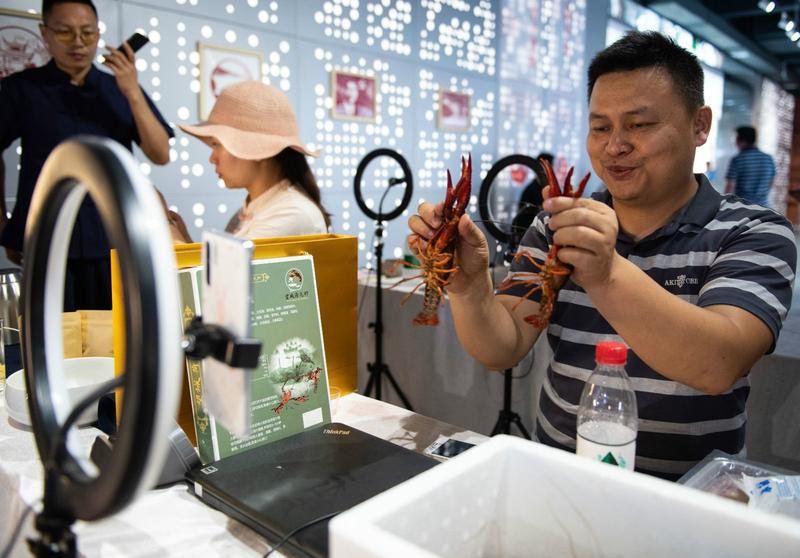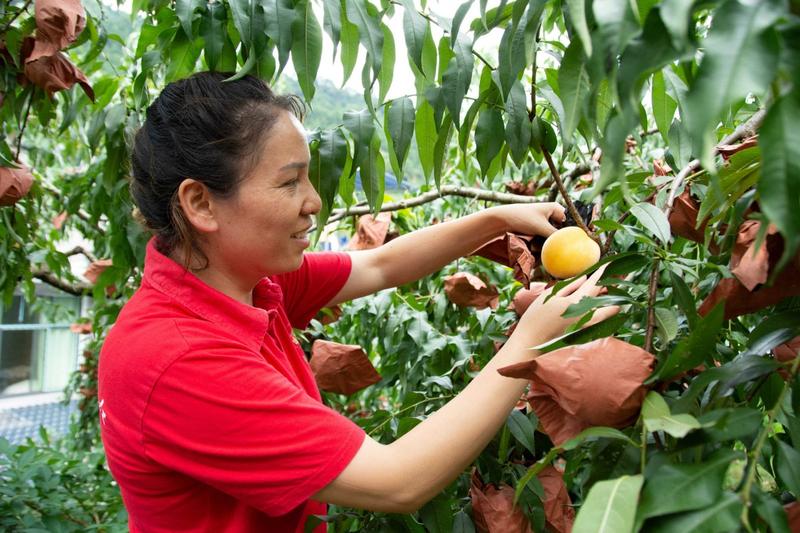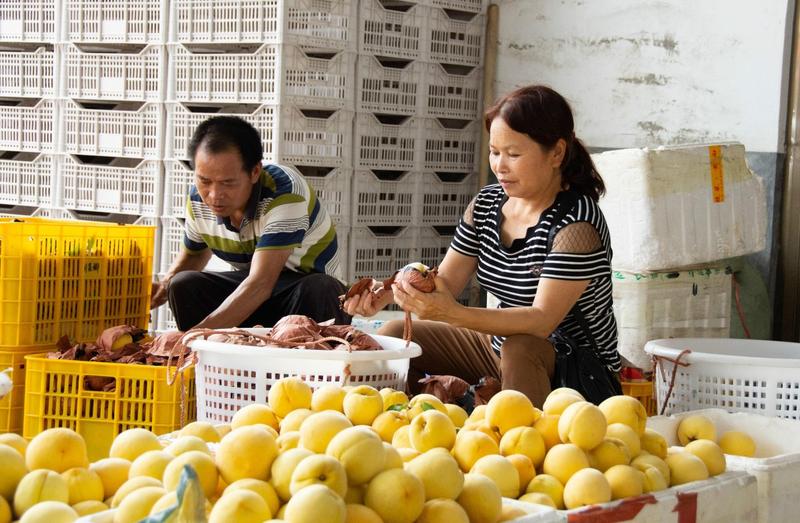The growth of geographical indication labels in Hunan province is boosting the quality and sales of local agricultural produce and helping to raise workers' incomes across several sectors, according to officials, industry insiders and farmers.
A geographical indication (GI) is a label displayed on products to show that they have a specific place of origin and are imbued with qualities or a reputation determined by that location's prevalent environmental or cultural factors.
As such, GIs are a form of intellectual property right and are widely used to protect products from being misrepresented.
A geographical indication (GI) is a label displayed on products to show that they have a specific place of origin and are imbued with qualities or a reputation determined by that location's prevalent environmental or cultural factors
According to Gu Wei, an official with the National Intellectual Property Administration, for goods to qualify for a GI label, several thresholds must be reached-one of the most difficult being that the product must be produced, processed and assessed under a series of unified standards.
Once a GI label is granted, it can play a significant role in boosting the development of a specific sector and local economy, said Gu, who is currently serving a placement as a deputy director of Sangzhi county, Hunan, to aid poverty alleviation efforts.
With that in mind, Gu and his colleagues are working to help more of the county's products-including black pigs and reed leaves used as wrapping for zongzi, a type of glutinous rice ball-to gain GI status.
Pioneers
Hunan already has several successful examples of GI products, such as Junshan crawfish from Junshan district, Yueyang city.
After being assigned GI status in March, the formerly little-known crawfish now has its own "ID card", which has helped win greater customer recognition and seen the price rise by 5 percent, said Zhou Yongjun, director of the Junshan Administration of Market Regulation.
"To achieve a GI label, Junshan's crawfish industry did a lot of work, including unifying standards of production and packaging, to improve the product's overall quality," he said.
"After gaining a GI label, the product's growing fame and higher quality make it more popular with consumers and help its price rise."
ALSO READ: Geographic indication spots a niche in market
Zhou said that to make the most of the opportunities brought by GI labels, the local crawfish association, processors and breeders joined together to form a complete industry chain.
"While the farmers focus on breeding crawfish, the industry association is responsible for organizing experts to provide lectures for them on policies, technologies, production standards, along with brand building and coordination. Companies purchase crawfish from breeders via orders, process them and then sell them," he said.
 In this undated photo, a local resident learns how to sell crawfish online during a livestreamed training session at a center in Wangcheng, Hunan. (CHEN SIHAN / XINHUA)
In this undated photo, a local resident learns how to sell crawfish online during a livestreamed training session at a center in Wangcheng, Hunan. (CHEN SIHAN / XINHUA)
A breeding base covering almost 4,800 hectares has been established in Junshan, and the 13 crawfish businesses in it have a daily trading volume of 580 metric tons.
The story is similar for Yanling yellow peaches, grown in Yanling county, Zhuzhou city, which were granted a national GI label in 2016.
Tan Zhongcheng, secretary-general of the Yanling Yellow Peach Industry Association, said the label means such fruit can only be labeled as a "Yanling yellow peach" if certain requirements are fulfilled-such as being grown at 300 meters to 1,000 meters above sea level in Yanling and meeting specific quality standards.
The association ensures that the peaches are grown, picked and packaged in line with a series of unified technologies and standards.
Compared with similar fruit grown by individual farmers without unified standards, Yanling yellow peaches are exposed to fewer chemical fertilizers.
They are also picked at a time that allows them to become fully ripe by the time they reach the stores so they taste sweet, and they are wrapped in better packaging, Tan said.
"That means they are well-received in the market, with 200 tons being exported to countries such as Singapore and Vietnam every year," he said.
Reducing poverty
The rise in sales of both the peaches and crawfish that resulted from successful registration as national GI products has helped lift local people out of poverty.
READ MORE: Geographical indications help to lift rural residents' incomes
Tan said 8,256 families are involved in Yanling's yellow peach industry, which produces 51,000 tons of the fruit every year. So far, the industry has lifted more than 4,700 families out of poverty, with each earning an average of 8,800 yuan (US$1,314) per annum.
 Chen Shidan, a fruit grower, picks yellow peaches at a village in Yanling county, Hunan province, on Aug 6, 2020. (LIU WANGMIN / XINHUA)
Chen Shidan, a fruit grower, picks yellow peaches at a village in Yanling county, Hunan province, on Aug 6, 2020. (LIU WANGMIN / XINHUA)
In Junshan, 201 of the 2,102 households classified as impoverished have been lifted out of poverty since members started working in the sector, Zhou said.
Before he started raising crawfish, Bai Hao, a farmer in Junshan's Wuyi village, grew vegetables, earning 3,000 to 4,000 yuan a year.
That was all the 50-year-old had to support his wife, who is unable to work because of severe rheumatoid arthritis, and pay her medical bills.
Life was difficult and the family was listed as impoverished in 2014.
Last year, noting the growth potential if the crawfish obtained a national GI label, village officials recommended that Bai should start breeding the popular delicacy.
Using a 50,000 yuan interest-free loan from the district government, he rented 27 hectares of paddy fields to breed crawfish.
The move proved successful; after Junshan crawfish gained national GI status in March, demand surged.
In summer, the harvest season for the delicacy, there were so many crawfish that Bai had to hire three people to help him catch them. He earned more than 100,000 yuan from his fields.
Promotion and protection
To boost sales of Junshan's GI agricultural products, the local market regulation administration cooperated with tourism agencies and encouraged outsiders to visit the district and purchase goods, according to Zhou, the administration's director.
On average, 350 visitors have purchased products every day since July, with each spending about 300 yuan, sending daily revenue to 105,000 yuan, he said, noting that the sales are expected to bring the district annual revenue of 30 million to 50 million yuan.
Junshan now has four GI-labeled products and moves are underway to extend the status to goods such as grapefruits, oranges, lotus roots, lotus seeds, rice and chiles.
 Residents of Pingle village in Yanling county, Hunan province, sort yellow peaches on Aug 6, 2020. (LIU WANGMIN / XINHUA)
Residents of Pingle village in Yanling county, Hunan province, sort yellow peaches on Aug 6, 2020. (LIU WANGMIN / XINHUA)
"We hope to have another five to 10 GIs within five years. On that basis, we want to build one or two leading brands into enterprises worth more than 5 billion yuan. We believe these steps will accelerate the development of agriculture and the district's agricultural produce processing industry," Zhou said.
Tan, from Yanling's yellow peach association, said while many fruits in Hunan and other provinces have sold poorly, sales of Yanling yellow peaches have risen, thanks partly to protection of the fruit's intellectual property rights.
"Customers believe in the quality of well-known brands. They love Yanling yellow peaches," he said, adding that the sales rise reaffirmed the power of branding to the growers and industry insiders.
To ensure long-term development, Tan said the association is paying greater attention to IPR protection and has obtained funding of 200,000 yuan from the Hunan Intellectual Property Administration for that purpose.
It has also cooperated with e-commerce associations and industry and commerce departments in Yanling and Zhuzhou to crack down on infringements of the Yanling yellow peach name.
In 2018 alone, the name was infringed more than 550 times and 375 types of counterfeit packages were detected.
Last year, the association began issuing licenses to business owners who sell the peaches online or offline. Only those who have obtained the association's license are allowed to sell the product, and violators face IPR infringement charges and being punished by the courts if found guilty.
Last year, 3,704 online or offline stores obtained licenses from the association, and at least 4,300 licenses have been issued so far this year, Tan said.
"These moves have helped protect the image of Yanling yellow peaches and boosted sales," he said.
Contact the writer at zhaoxinying@chinadaily.com.cn


